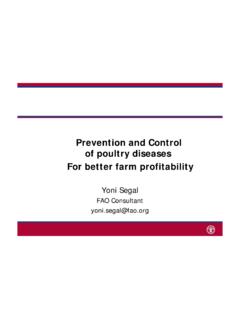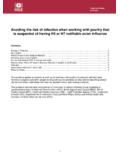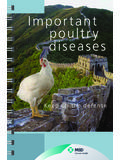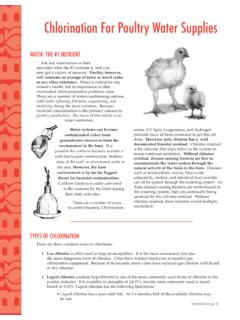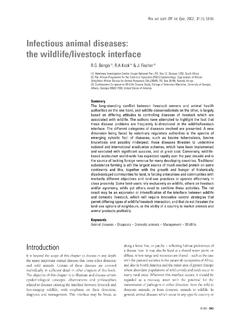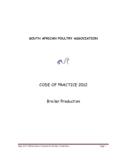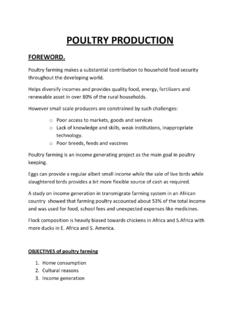Transcription of Rational use of vaccination for prevention and control of ...
1 1 VOL 10 | MAY 2016 1 Abstract/overview1 Why opt for vaccination ?3 Principles of Rational vaccine use4 Key questions in designing a vaccination strategy for disease prevention and control6 Potential drawbacks of vaccine use7 Does use of vaccination lead to endemic infection?7 Conclusion8 ReferencesAbstract/overviewVaccination can play a valuable role in con-trol, prevention and elimination of highly pathogenic avian influenza (HPAI) viruses. In places where HPAI remains endemic, vaccine has been used to reduce the quantities of vi-rus shed into the environment, which, in turn, reduces human exposure and the likelihood of zoonotic and pandemic influenza, as well as the risk of severe disease in poultry . In other countries (China, Hong Kong SAR and Mexico), vaccination has been used successfully to as-sist in the elimination of virus.
2 Despite these positive experiences, considerable resistance to use of vaccine exists because of perceived and actual adverse consequences associated with vaccination as well as concerns about availability of sufficient resources to conduct vaccination programmes. The adverse effects can be overcome or managed, and benefits of vaccination maximized if vaccine is used ra-tionally. Rational use involves five core prin-ciples and requires: i) clear objectives and regular reviews of progress towards these objectives; ii) design of the programme so as to achieve high-level immunity in vaccinated populations through use of appropriate, lo-cally-registered vaccines and implementation of post- vaccination monitoring; iii) passive surveillance systems able to identify flocks in which virus might be circulating so that these can be reported and investigated; iv) applica-tion of other appropriate management prac-tices and biosecurity measures at farms and markets aimed at reducing the risk of infection with HPAI: and v) an appropriate cost-sharing mechanism with the private sector.
3 Why opt for vaccination ?Since it emerged in 1996, HPAI caused by Goose/Guangdong-lineage H5 viruses (H5 HPAI) has become a major risk and constraint to poultry production on four continents and a cause of sporadic severe zoonotic disease in humans. It also remains as a potential hu-man pandemic influenza threat. In most plac-es, control of avian influenza can be achieved primarily by stamping out. However, the ef-fectiveness of this strategy depends on early detection of all infected poultry and swift ac- Rational use of vaccination for prevention and control of H5 highly pathogenic avian influenzaContributors: Les Simsa, Astrid Tripodib, Sophie von Dobschuetzb, Emma Gardnerb, Ryan Aguannoba, b (See back cover)2 VOL 10 | MAY 2016tion to prevent these birds from spreading the virus. The costs of stamping out are high, not only in terms of the intervention itself but be-cause of the compensation provided to affect-ed owners, which is necessary to encourage reporting and to help defray losses to people s suggests that virus elimination in poultry is unlikely in a number of countries where the virus remains endemic (FAO, 2012).
4 In these places, all available tools for preven-tion and control of the disease should be con-sidered, including vaccination using appropri-ate and quality biologicals. Table 1 provides possible scenarios for the use of vaccination . control and elimination of H5N1 is achieved by reducing the number of infected and sus-ceptible poultry , thereby also reducing the amount of circulating virus able to establish onward can help achieve these objec-tives by increasing resistance to infection, de-creasing the likelihood of disease and reduc-ing shedding of the virus in those birds that do become infected. Unvaccinated infected chickens shed much higher concentrations of virus than their vaccinated, infected coun-terparts (Swayne, 2006). Once vaccinated, marked reduction of onward transmission of virus can occur within seven days post-vac-cination (van der Goot et al.)
5 , 2005). In one ex-ample in China, Hong Kong SAR, in which vac-cination was used in the face of an outbreak, transmission ceased within 18 days (Ellis et al., 2006).Despite the potential benefits of vaccina-tion, many countries continue to restrict their control options to stamping out even after it is evident that this method is not working as in-tended. This creates a major burden for poul-try producers and does not halt the spread of disease as farmers will often sell flocks of poultry when they first notice increases in mortality, which, in turn, exacerbates the out-break and increases the public health risk in the case of zoonotic influenza viruses. Table 1 Different scenarios for the use of vaccination as a tool in HPAI controlScenariosRecent outbreak in a country previously free of the virusWhen stamping out alone is not achieving virus elimination in an infected countryWith no prospect of virus elimination in the next 2+ years in an endemic countryObjectiveVirus eliminationVirus eliminationOutbreak containment and reduction in virus circulationUse of vaccination and other measuresEmergency vaccination with stamping outTargeted vaccination added as a control measure to facilitate stamping outTargeted vaccination ;Less emphasis on stamping out.
6 Introduce changes to farm and market practices to reduce risk VaccinesNeed to have a stockpile of suitable vaccineLocate and use suitable vaccineLocate and use suitable vaccineOther requirementsRapidly detect all infected flocks and take swift actionDetect infected flocks and take swift action;Regularly review scope, effectiveness and the need for vaccinationRegularly review scope, effectiveness and the need for vaccination . If/when feasible revert to virus eliminationDurationShort (if successful)Short to mediumUsually longNote: Distinct from Nepal isolates; detected in poultry and wild birds (crows). vaccination is performed on newly hatched chicks. FAO/Astrid Tripodi FAO/Sia KambouMinimizing unwanted consequences: When implementing a vaccination programme, sev-eral challenges need to be faced, all of which can be overcome or minimized.
7 Concerns in-clude: viral shedding in clinically healthy, vacci-nated birds, or the so-called silent infec-tion (see, for example, Poetri et al., 2014); the use of vaccination as a substitute for other important measures, such as im-provements to biosecurity; a false sense of security leading to the un-derestimation of clinical signs consistent with HPAI or of milder clinical signs, jeop-ardizing the immediate detection of HPAI in vaccinated flocks (Vergne et al., 2012); the potential impact on trade in poultry products (Pongcharoensuk et al., 2012; the emergence of antigenically variant strains (Cattoli et al., 2011).Though each of these concerns is legit-imate, the Rational use of vaccination can help ensure that the overall effect remains An aviary technician vaccinates a chicken at a training session for poultry farmers in 10 | MAY 2016 What vaccines are available?)
8 Two main types of poultry vaccine are availa-ble for avian influenza at present: killed anti-gen in an oil-based adjuvant and vaccines that rely on a viral vector to deliver the antigen vaccines have been used for decades in the prevention and control of avian influenza and work effectively. They require in-dividual injection of birds and usually multiple doses are needed starting at about two weeks of age. In some countries, a withdrawal peri-od applies before birds can be sent to slaugh-ter for consumption, as specified by the man-ufacturer and/or veterinary authorities. This can limit the value of vaccination in short-lived meat birds. (However, no known public health risk is associated with consumption of a vaccinated chicken; the withdrawal period is related to the additives mixed in the vaccine to improve its stimulatory properties or preserv-atives).
9 Maternal antibodies (conferred via egg yolk in the embryo) can interfere with the immune response generated by these vac-cines (Maas et al., 2011) and generally vanish by two to three weeks of age after hatching. When these are expected to be present (if parent stock has been well vaccinated or ex-Box 1 Real-life examples: Success of vaccination against avian influenza China, Hong Kong SAR, Italy, Mexico, United States of America, Viet NamVaccines were first used successfully against low pathogenic avian influenza (LPAI) viruses and these experiences demonstrated the potential for use against highly pathogenic avian influenza (HPAI) viruses. poultry in turkey farms in the United States of America were among the first to be vaccinated successfully against a range of LPAI viruses (Halvorson, 2009).)
10 vaccination since has been used effectively in a number of places including northern Italy (LPAI), Mexico (H5 and H7 HPAI) and China, Hong Kong SAR (H5 HPAI) to prevent infection and to control and eliminate virus. In these places, vaccination was coupled with other measures such as raised biosecurity standards, active surveillance and stamping out. Other countries where avian influenza virus was endemic and where stamping out had not achieved the desired goal have used vaccination to reduce viral loads. The experiences with HPAI in Viet Nam during 2003 2004 warrant consideration given that some 45 million head of poultry had been lost, most through culling. This loss represented 17 percent of the total standing poultry population. It is likely that depopulation did reduce viral loads, but by 2005, Viet Nam was experiencing more human cases of Influenza A(H5N1) disease than any other country, demonstrating that any positive effects from the stamping out were short-lived.










